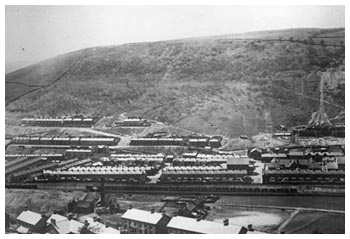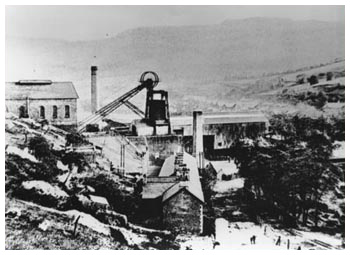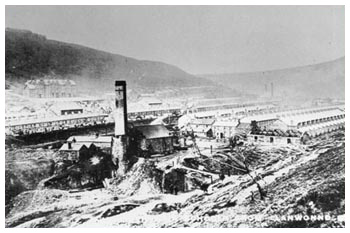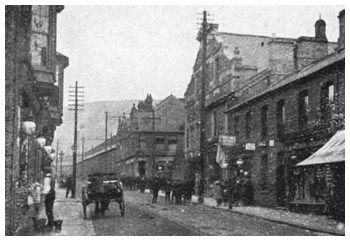
Ynyshir |
|
In common with many of the villages of the Rhondda Ynyshir is named after a farm that stood on the land pre-industrialisation. The translation of the name could be taken as ‘long riverside meadow'. As early as the 1840's mention is made of the ‘small mining settlement at Ynys-hir'. The nature of Ynyshir's position made it particularly tempting to mining speculators. It is only a mile from the ‘Gateway to the Rhondda' making transportation easier and its wide meadows were in marked contrast to much of the narrow valley of the Rhondda Fawr. |
|
| Mining in Ynyshir really began with the sinking of the colliery of Messrs. Shepherd and Evans, trading as the Ynyshir Coal Company, in 1845. This colliery was subsequently purchased and extended by Francis Crawshay in 1856, in order to supply coal to the Crawshay Ironworks at Treforest. Mining for steam coal in the area began when James Thomas, the chief partner of Troedyrhiw Colliery Company leased the mineral rights to a tract of land at Ynyshir. He sunk the Standard Collieries on the site, number one pit being sunk in 1875, and number two the following year. These pits eventually struck the Rhondda 4 Foot steam in 1877 and 1878 respectively. |  |
 |
Ynyshir coal became highly esteemed both by the Admiralty and in the lucrative export markets, being particularly popular in France. In 1914 Standard amalgamated with the United National Collieries Limited. Later in 1904, the Lady Lewis colliery was sunk by Lewis Merthyr Consolidated Collieries Limited, and was connected underground to the companies Hafod collieries further down the valley. Left: Lady Lewis Colliery Circa 1900 |
The 1906 Kelly's Industrial Directory describes Ynyshir as ‘ a town on the river Rhondda-fach, with a station on the Rhondda-fach branch of the Cardiff, Pontypridd and Merthyr railway'. The Taff Vale railway had reached Ynyshir in 1849, and the town boasted its own station. Ynyshir in 1926 boasted its own parish church, St. Anne's erected in the 1880's, as well as a number of chapels including: English and Welsh Wesleyan Methodist, an English Baptist chapel erected in 1885 and seating 350 people, a Welsh Baptist Chapel erected in 1884 with a capacity of 800, and a Welsh Congregational Chapel erected in 1885 seating 800 people. Right: Jones Colliery Circa 1905 |
 |
Ynyshir Institute Circa 1910 |
In common with many of the mining villages the hub of Ynyshir's social and cultural life became the miners institute. The Ynyshir Standard Colliery Workmen's hall and Institute was opened in 1905 and was built at a cost of £8,000. The Institute comprised a hall capable of holding 1,500 persons, a library and reading room, a reading committee, two billiard tables and a gymnasium. The principal landowners in the area, at that time, are listed as; Lord Colum. E. Crichton-Stuart, Col. John Picton Turbevill, of Ewenny Priory, the Earl of Plymouth, Theophilus R. Hamlen-Williams and the trustees of the Bailey Estate. The area also had two public elementary schools, a boys school erected in 1882 and remodelled in 1905, and a girls and infants school erected in 1903 at accost of £13,500.
|
